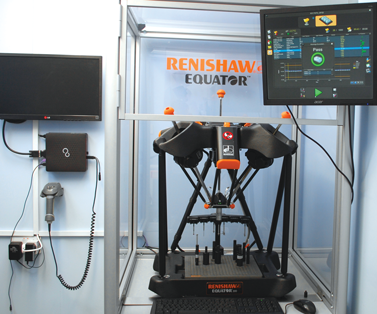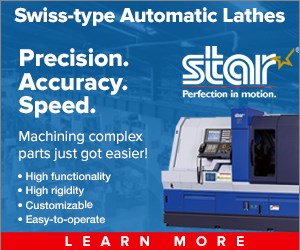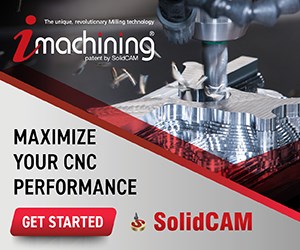Quality Gaging System Cuts Production Costs
With its latest addition of a Renishaw Equator gaging system, High-Tech Enginnering is reaching 100-percent part inspection and zero scrap, which has halved the operator requirements and has reduced part production costs by 27 percent.
The product quality a company produces and its assurance of that quality can mean all the difference to successfully acquiring contracts. Maintaining that quality also significantly increases the chances of repeat business. High-Tech Engineering, a precision engineering company based in Bedfordshire, U.K., has always focused on the quality of the parts it produces. Now, with its latest addition of a Renishaw Equator gaging system, the company is reaching 100-percent part inspection and zero scrap, which has halved the operator requirements and has reduced part production costs by 27 percent.
Started in 1985 by Managing Director Steve Tickner, High-Tech has built a reputation in the motorsport industry for delivering high quality machined parts. The company has since moved into the aerospace sector and gained some key industry approvals, including becoming a preferred supplier to Rolls-Royce and BAE Systems.
Recently, High-Tech won a contract to produce precision milled titanium parts for a large aerospace customer. Because of the nature of the parts, High-Tech was instructed to carry out 100-percent part inspection.
“We knew from the start that we would need to find an inspection method that could not only meet the cycle time requirements for the part, but would be a cost-effective solution for us as well,” Mr. Tickner says. “Relying on the CMM we already had wasn’t going to be an option. We couldn’t risk any bottlenecks. We knew we would either need another CMM or something else that could give us the measuring capacity. That’s what led us to the Renishaw Equator.”
It was through a simple internet search that Mr. Tickner came to learn of the Equator gaging system. After some research and meetings with representatives from Renishaw, he was impressed with what the system offered and was particularly pleased with the price of the system.
“Space on our factory floor is at a premium,” Mr. Tickner says. “Within the space we set aside for this cell, we had to include faster, more efficient technology. This meant that a CMM with a temperature-controlled environment was far too big to be practical. The Equator suited the space perfectly since it’s a compact machine. The added bonus is the fact it is thermally insensitive and doesn’t require an air supply, meaning we didn’t need to spend additional time and money to put in another temperature controlled-room or extra piping.”
The new gaging system works by comparing the manufactured parts with a matching master part, gaging all the features in a single operation with an immediate pass/fail decision, along with a report of the component dimensions.
The system can gage about 150 features, including a number of bores, thicknesses and form measurements on the part with typical tolerances of ± 25 microns. It does this within 10 minutes and well within the production requirements, which is less than the machining time. This is almost a 50-percent reduction in cycle time compared with running the program on High-Tech’s CMMs.
The gaging system is fully programmable and can be used on multiple parts. High-Tech can perform highly repeatable and rapid, automated routines across numerous contracts, resulting in significantly reduced labor costs.
Production at High-Tech runs 24 hours per day, five days per week and is split into two overlapping shifts. During this time, the Equator is used by a number of operators with varying skill sets. Previously, the company would have relied on its CMMs, housed away from the machine tool in a temperature-controlled quality room. Using the CMM for the latest job would have involved two separate operators—the operator machining the part and the operator with the specialist skills to operate the CMM. By using an Equator instead, newly trained staff can use dimensions from a certified component, approved by the QC operators, to “zero” the new gaging system and set its accuracy for subsequent measurements. This has allowed the same operator who machined the part to measure the part, cutting the operator time required in half.
“All of the operators can use the new gaging system,” according to Mr. Tickner. “It really is easy; load the part and push the button. It completely simplifies the process and frees up manpower, which, in turn, helps to deliver ROI very rapidly for the cell.”
High-Tech has managed to reduce the cost of producing the aerospace part by 27 percent with the new gaging system being a factor in that. This has had an impact on competitiveness, allowing the company to make the same precision quality parts, while also delivering better value to its customers.
It is through implementing these types of solutions and continually striving to improve its processes that High-Tech has been awarded six consecutive SC21 silver awards, which is unrivalled in the U.K. This award recognizes excellence within the aerospace and defense industry, for the quality of the products a company produces, as well as its ability to supply them. To receive a silver award, a company must consistently achieve at least 95 percent for delivery performance and at least 99.5 percent for part quality to all of its customers.
“Since we started using the Equator, we have not made a single bad part,” Mr. Tickner says. “The system is allowing the operators to operate complete process control. They all look at the Process Monitor screen, part of the Equator software, which lists all of the features being gaged. Next to the feature name, there is a little bar that turns from green to amber to red as the size or location for each feature begins to drift. The operators know which tool on the machine is responsible for each feature so they can take corrective measures to occasionally tweak the process, to come back well within tolerance. As we carry out 100 percent inspection, it would be hard to make a part wrong.”
High-Tech is also using the gage data to try different types of tools to see which ones provide the best level of efficiency—something that might save more money in the future.
Following the success of this manufacturing cell, Mr. Tickner plans to use the Equator gaging system as part of future cells he will be commissioning for jobs in the pipeline.
“When you find something that helps you make a perfect part every time, and reduces manpower commitments and overall costs and doesn’t cost a fortune, it’s a winning solution,” he says. “All of the benefits are passed on to our customers who know they are getting the best quality at the best price.”
For more information from High-Tech Engineering, visit www.high-tech-eng.co.uk.
Related Content
How Well do You Know Granite Surface Plates?
Here are some tips for choosing, maintaining and customizing a granite solution that will best meet your shop’s particular inspection needs.
Read MoreStreamlining Part Measurement, Data Collection Processes
When collecting measurement data automatically with a wireless data collection system, manual errors can be eliminated ensuring data accuracy and traceability.
Read MoreThe Difference Between Ra and Rz
While it is best to measure using the parameter specified in the print, there are rules of thumb available that can help clear up the confusion and convert Ra to Rz or Rz to Ra.
Read MoreReplace Repetitive Measurement With DIY Robotic Automation
After minimal training, a shop can learn how to use this robotic inspection system configured for a shopfloor application to supersede repetitive, time-consuming, high-mix gaging processes. It can then be redeployed for another application somewhere else in the facility.
Read MoreRead Next
Fielding Manufacturers’ FAQs about CMMC
Here are answers to frequently asked questions we as a provider of testing, consulting, information and compliance services receive about Cybersecurity Maturity Model Certification.
Read MoreAvoid the 7 Deadly Sins of Manufacturing
Identifying and preventing these manufacturing sins will reduce or eliminate unnecessary waste, improve efficiency and productivity as well as protect profitability and cash flow.
Read MorePredicting the ROI of Robotic Automation
Various methodologies paired with online tools can help small to mid-sized manufacturers determine how to predict and calculate the potential economic benefits of robotic equipment for their specific needs.
Read More


























